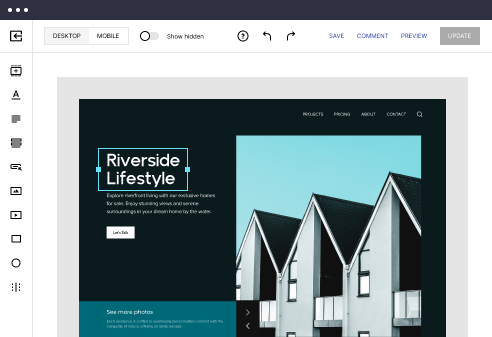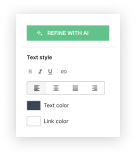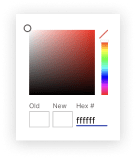
React.js optimized support page template
Explore Similar TemplatesAbout template
Supercharge your support page with React.js for outstanding performance! Learn more today.
Recommended templates
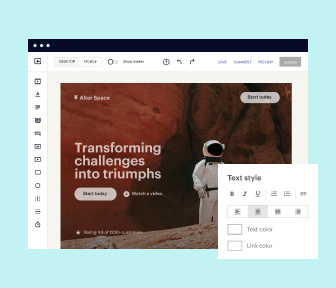
Easy to build without coding
With the intuitive drag-and-drop builder, anyone on your team can create high-converting pages without any knowledge of code or design. Make enhancements to your landing page with custom widgets using Javascript, HTML/CSS, or third-party scripts.
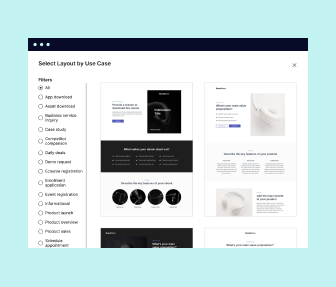
Multiple layouts for any industry and goal
Select from 500+ landing page layouts built to boost conversions across industry-specific scenarios. Customize them by adjusting fonts, adding images, and generating on-brand content with the AI assistant. Quickly scale with Instablocks® and Global Blocks that you can save, reuse, and update globally.
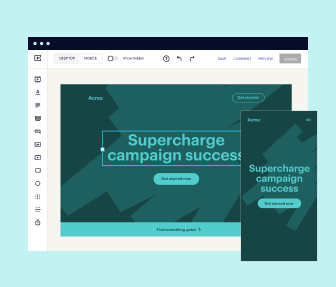
Loads fast and looks polished on any device
Every template is responsive, which means they present professionally on any device and load blazingly fast with our Thor Render Engine. You can also power them up with Google AMP technology to deliver an unparalleled mobile experience and drive higher conversions.
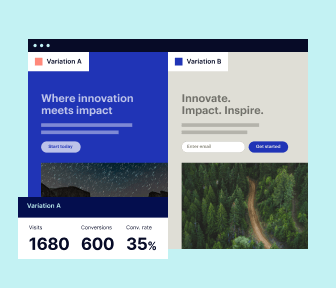
Robust analytics & experimentation
Get real-time updates and reporting across all your devices, showing the number of visitors, conversions, cost-per-visitor, and cost-per-lead. Launch AI-powered experiments, run A/B tests, and use heatmaps to analyze user behavior, then optimize your landing page to maximize conversions.

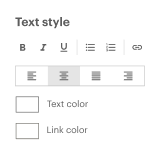
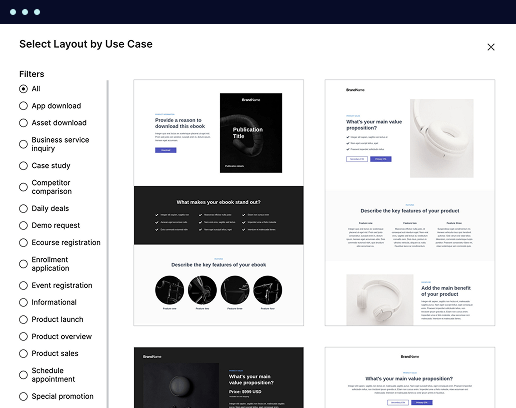
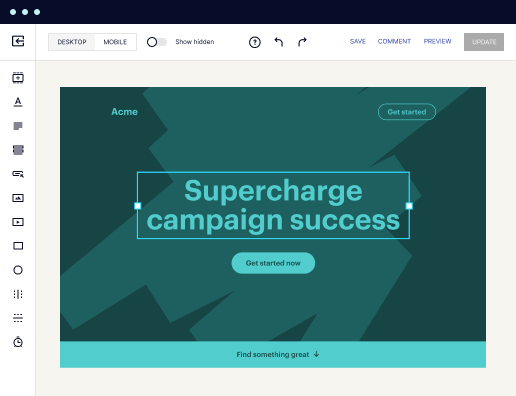
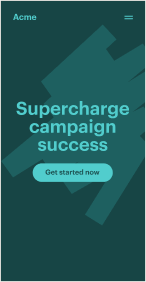
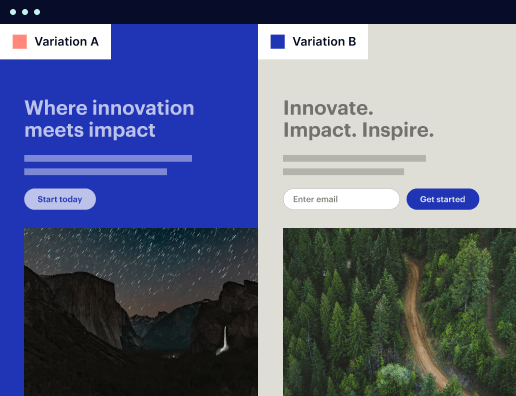

Easy to build without coding
With the intuitive drag-and-drop builder, anyone on your team can create high-converting pages without any knowledge of code or design. Make enhancements to your landing page with custom widgets using Javascript, HTML/CSS, or third-party scripts.
Multiple layouts for any industry and goal
Select from 500+ landing page layouts built to boost conversions across industry-specific scenarios. Customize them by adjusting fonts, adding images, and generating on-brand content with the AI assistant. Quickly scale with Instablocks® and Global Blocks that you can save, reuse, and update globally.
Loads fast and looks polished on any device
Every template is responsive, which means they present professionally on any device and load blazingly fast with our Thor Render Engine.
Robust analytics & experimentation
Get real-time updates and reporting across all your devices, showing the number of visitors, conversions, cost-per-visitor, and cost-per-lead. Launch AI-powered experiments, run A/B tests, and use heatmaps to analyze user behavior, then optimize your landing page to maximize conversions.
All the features you need to build lead-generating landing pages
Explore more featuresLearn how to build top-performing landing pages for any goal
FAQs
Leading the way in building high-performing landing pages





Maximize Your ROI with Instapage: The Ultimate Landing Page and CRO Platform
Instapage stands out as the most powerful landing page and conversion rate optimization platform designed to enhance digital marketing strategies. By leveraging its comprehensive tools, marketers can accelerate their campaign performance, optimize user experiences, scale their efforts, and ultimately maximize ROI. This guide will walk you through how to effectively utilize Instapage for creating high-converting landing pages tailored to your business needs.
Why Choose Instapage for Landing Page Creation?
Instapage offers a unique set of features that simplify the landing page creation process. Whether you are in business services, tech, or education, the platform provides 100+ ready-to-use templates that cater to various industries. Marketers can create pages without coding, utilizing drag-and-drop functionality that streamlines the design process.
- High-converting templates: Choose from over 100 templates optimized for conversion, enabling you to create pages that generate leads quickly.
- No coding required: Build your landing pages with an intuitive editor that eliminates the need for technical skills.
- Dynamic text replacement: Personalize your landing pages in real-time to align with your ad copies for improved relevance.
Step 1: Accessing Templates and Lead Generation Elements
Start by logging into Instapage and navigating to the template library. Here, you can browse through various high-converting designs tailored for different market segments.
Step 2: Optimizing Your Landing Pages
Optimization is key to achieving higher conversion rates. Instapage allows you to utilize A/B testing and detailed heatmaps to monitor user behavior on your landing pages.
- A/B testing: Experiment with different headlines, calls-to-action, and images to see what resonates best with your audience.
- Heatmaps: Utilize heatmaps to visualize where visitors are clicking, allowing you to adjust your layout for optimal performance.
- Analytics dashboard: Access comprehensive performance metrics to gauge the effectiveness of your campaigns.
Step 3: Collaborating with Your Team
Collaboration features in Instapage facilitate efficient communication and feedback among team members. You can share your landing pages securely with external stakeholders for reviews and suggestions.
- Real-time editing: Make live changes and receive instant feedback from collaborators to speed up production.
- Secure sharing: Send links to your landing pages that restrict access to unauthorized users.
- Commenting tool: Engage in discussions directly on the landing pages to keep notes and streamline the review process.
In conclusion, Instapage serves as a robust tool that empowers marketers to create effective landing pages, optimize their performance, and enhance team collaboration. By implementing these strategies, you can significantly improve your digital marketing efforts.
Ready to elevate your marketing campaigns? Sign up for Instapage today and start creating landing pages that convert. Experience the undeniable impact of well-optimized pages on your ROI.
React.js optimized support page template
Understanding the importance of optimized support pages
Support pages play a vital role in user experience, acting as the bridge between users and services. When users encounter issues or need assistance, these pages are often their first point of contact. A well-structured support page can significantly reduce frustration and confusion, helping users find the answers they need quickly. This seamless interaction not only enhances user satisfaction but also strengthens their relationship with the brand.
The impact of optimized support pages extends to customer retention. By providing comprehensive resources and solutions, businesses can reduce churn rates and foster loyalty among their customers. An efficient support system directly contributes to overall customer satisfaction, which is crucial in today's competitive landscape.
Why React.js for support page development?
React.js offers several advantages for developing optimized support page templates. First, it provides efficient rendering and excellent performance, which is critical for ensuring users have a smooth and responsive experience. React's virtual DOM allows for quick updates without reloading the entire page, making it ideal for real-time support interactions.
Secondly, React's component-based architecture supports scalability. Developers can create reusable components, which not only speeds up the development process but also maintains consistency across the support page. This modularity allows teams to efficiently implement changes and add new features as user needs evolve.
Finally, React.js boasts a robust community and a rich ecosystem. Developers benefit from a wealth of third-party libraries and tools, making it easier to implement functionalities such as state management and routing, and enhancing the overall development workflow.
Essential features of React.js optimized support page templates
An effective support page must include several key components to function well. The header typically features branding and navigation that guide users to different parts of the support site. This foundational element sets the tone and provides users with context immediately upon arrival.
The sidebar complements the header by offering quick access to frequently asked questions (FAQs) and other valuable resources. This ensures users can find answers without sifting through irrelevant content, ultimately leading to a more efficient experience.
The main content area is crucial as it dynamically renders information based on user queries. This could include text, images, or even videos that provide solutions tailored to specific user issues. Finally, the footer wraps up the page by including links to additional resources and contact information, establishing a route for users who need further assistance.
Rich interactivity and customization
One of the most significant advantages of using React is its ability to create rich interactive experiences. Utilizing React Hooks allows developers to effectively manage state, making it easy to update portions of the user interface without lengthy reload times. Incorporating user feedback components such as rating systems and comments can also significantly enhance user engagement.
Moreover, utilizing CSS-in-JS libraries like styled-components enables developers to implement responsive design strategies that adapt seamlessly to different devices. This flexibility ensures that users have a consistent experience across desktops, tablets, and mobile devices.
Building a support page template from scratch
Creating a support page template from the ground up requires a clear workflow and an organized approach. The first step is setting up the React environment using essential tools, including Node.js and Create React App. This initial setup lays the foundation for the project, ensuring everything is ready for development.
Next, structuring the project is critical. Establish a well-defined directory layout and component hierarchy to facilitate easy navigation and maintainability. This strategy not only aids development but also helps future developers understand the project's structure quickly.
Creating component templates
When developing the support page's component templates, focus on consistency and reuse. Begin by crafting a dynamic header that includes navigation features to allow users to switch between various sections of the support page easily. This creates a seamless user experience and keeps users engaged.
Additionally, creating a sidebar with collapsible sections for FAQs will keep the interface organized and user-friendly. The footer should also be designed carefully to include essential links, including legal information, as well as quick access to contact details that users might need.
Integrating content management systems (CMS)
Integrating a headless CMS into your support page template provides unparalleled content flexibility. By using a CMS, content updates can occur without requiring alterations to the underlying code. This means marketers and content creators can manage resources efficiently.
Connecting APIs to fetch live support data is essential to maintain relevancy in the information provided. This integration enables the support team to deliver up-to-date FAQs, tutorials, and articles, ensuring users always have access to the latest solutions.
Enhancing user interaction and accessibility
Building an optimized support page template needs to prioritize user-centric features. Search functionality is a critical addition that allows users to quickly locate the information they're seeking. By implementing an intelligent search bar, you can guide users through common issues with ease.
Interactive elements, such as buttons or tooltips, can lead users through the support page more effectively. These features not only enhance user experience but also encourage users to engage more deeply with the content.
Accessibility best practices
Accessibility is a fundamental aspect of any support page. Ensuring keyboard navigability allows users who may have difficulties with a mouse to access all features of the support page seamlessly. Additionally, compatibility with screen readers makes your content available to visually impaired users, fostering inclusivity.
Implementing suitable color contrast and providing text scaling options can further enhance the usability of your support page. These measures are essential for ensuring that all users, regardless of their abilities, can effectively navigate and utilize the page.
Testing and optimizing the support page template
Once the support page is developed, testing and optimization are paramount. Performance optimization techniques, such as code splitting, can be employed to improve load times and overall efficiency. By breaking your app into smaller chunks, you avoid overwhelming users with large files and enhance their experience.
Lazy loading components is another effective strategy. With this technique, only the components that users will encounter immediately are loaded, further improving initial load times. As users interact with the page, additional components are loaded as needed.
Previews and user testing
Conducting A/B tests is an excellent way to assess user engagement on your support page. By comparing different versions of your support page, you can gain insights into what features and designs resonate most with users. Gathering feedback from communities and internal teams can provide valuable data to inform future enhancements.
Lastly, analyzing metrics using tools like Google Analytics and heatmaps is crucial for continuous improvement. Understanding user behavior and interactions can guide developers to make informed decisions for future iterations of the support page.
Real-world applications and success stories
Several companies have successfully implemented optimized support page templates using React.js, highlighting the effectiveness of this technology. In one case study, a SaaS company saw a drastic reduction in customer support inquiries after launching a comprehensive support page. By providing accessible resources, they empowered users to find solutions independently.
Businesses that employ React.js for their support pages report improved customer support efficiency as a result. With intuitive navigation and well-structured content, users can quickly locate information, leading to higher satisfaction rates.
Community contributions and innovations
The React.js community is robust, filled with innovative ideas and open-source contributions that benefit support page development. Various plugins and components have emerged from community collaboration, allowing others to build upon proven structures and features without reinventing the wheel.
Community feedback often shapes the evolution of tools and techniques available for React developers. As developers engage, share experiences, and propose improvements, the overall quality of React.js support pages continuously enhances, driving better user engagement.
Future trends in support page development with React.js
As technology evolves, so too does support page development with React.js. The use of artificial intelligence and machine learning is becoming increasingly prevalent, enabling one-to-one personalization based on user behavior and historical data. This level of customization can significantly enhance the user experience, ensuring that individual needs are met efficiently.
Implementing chatbots and virtual assistants is another emerging trend in the support ecosystem. These tools can supplement human assistance by answering common queries and guiding users through troubleshooting steps, thereby increasing the efficiency of the support process.
Evolving web technologies and their influence
The rise of server-side rendering frameworks like Next.js and Gatsby is influencing how support pages are structured. These frameworks not only improve load times but also enhance SEO, thus driving organic traffic to support resources. Progressive Web Apps (PWAs) are paving the way for improved accessibility, enabling users to interact with support pages offline and across different devices.
Navigating the React.js development community
Engaging with online communities is vital for staying current with React.js development practices. Platforms like GitHub and Stack Overflow provide forums for collaboration and problem-solving, facilitating opportunities to learn from peer experiences. Joining meetups and local collectives can result in valuable networking experiences that bolster one's development career.
There are numerous resources available for continuous learning. Engaging with recommended courses, blogs, and podcasts can help developers stay updated with the latest React.js features and best practices. By actively participating in community discussions and leveraging these resources, developers can refine their skills and stay at the forefront of support page innovation.
Ready to skyrocket conversions?
Supercharge your ad campaigns with high-performing landing pages
Get started